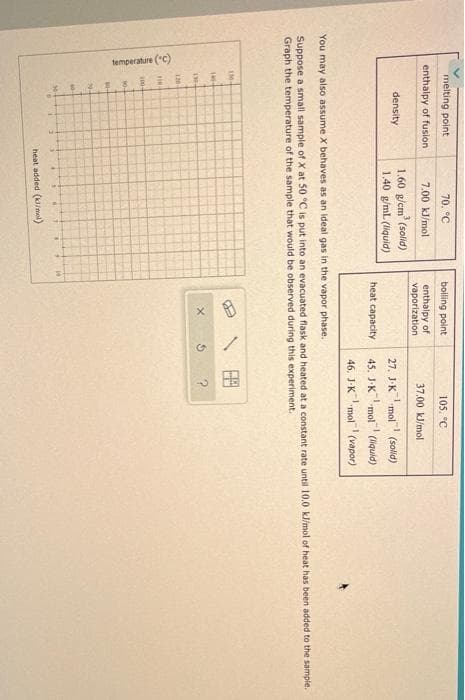temperature (C) melting point 70. °C boiling point 105. °C enthalpy of fusion 7.00 kJ/mol enthalpy of vaporization 37.00 kl/mol 1.60 g/cm' (solid) 1.40 g/ml (liquid) density 27, J-Kmol (solid) 1- heat capacity 45. J-Kmol (liquid) 46. J-Kmol (vapor) You may also assume X behaves as an ideal gas in the vapor phase. Suppose a small sample of X at 50 °C is put into an evacuated flask and heated at a constant rate until 10.0 kl/mol of heat has been added to the sample Graph the temperature of the sample that would be observed during this experiment. 田
temperature (C) melting point 70. °C boiling point 105. °C enthalpy of fusion 7.00 kJ/mol enthalpy of vaporization 37.00 kl/mol 1.60 g/cm' (solid) 1.40 g/ml (liquid) density 27, J-Kmol (solid) 1- heat capacity 45. J-Kmol (liquid) 46. J-Kmol (vapor) You may also assume X behaves as an ideal gas in the vapor phase. Suppose a small sample of X at 50 °C is put into an evacuated flask and heated at a constant rate until 10.0 kl/mol of heat has been added to the sample Graph the temperature of the sample that would be observed during this experiment. 田
Chemistry: The Molecular Science
5th Edition
ISBN:9781285199047
Author:John W. Moore, Conrad L. Stanitski
Publisher:John W. Moore, Conrad L. Stanitski
Chapter9: Liquids, Solids, And Materials
Section: Chapter Questions
Problem 116QRT
Related questions
Question

Transcribed Image Text:temperature ("C)
melting point
70. °C
boiling point
105. °C
enthalpy of fusion
7.00 kJ/mol
enthalpy of
vaporization
37.00 kJ/mol
1.60 g/cm (solid)
1.40 g/ml. (liquid)
density
27. J-Kmol
(solid)
heat capacity
45. J-Kmol (liquid)
46. J-Kmol (vapor)
You may also assume X behaves as an ideal gas in the vapor phase.
Suppose a small sample of X at 50 °C is put into an evacuated flask and heated at a constant rate until 10.0 kJ/mol of heat has been added to the sample.
Graph the temperature of the sample that would be observed during this experiment.
田
110-
heat added (k/mel)
Expert Solution
This question has been solved!
Explore an expertly crafted, step-by-step solution for a thorough understanding of key concepts.
Step by step
Solved in 4 steps with 2 images

Knowledge Booster
Learn more about
Need a deep-dive on the concept behind this application? Look no further. Learn more about this topic, chemistry and related others by exploring similar questions and additional content below.Recommended textbooks for you

Chemistry: The Molecular Science
Chemistry
ISBN:
9781285199047
Author:
John W. Moore, Conrad L. Stanitski
Publisher:
Cengage Learning

Introductory Chemistry: A Foundation
Chemistry
ISBN:
9781337399425
Author:
Steven S. Zumdahl, Donald J. DeCoste
Publisher:
Cengage Learning

Chemistry by OpenStax (2015-05-04)
Chemistry
ISBN:
9781938168390
Author:
Klaus Theopold, Richard H Langley, Paul Flowers, William R. Robinson, Mark Blaser
Publisher:
OpenStax

Chemistry: The Molecular Science
Chemistry
ISBN:
9781285199047
Author:
John W. Moore, Conrad L. Stanitski
Publisher:
Cengage Learning

Introductory Chemistry: A Foundation
Chemistry
ISBN:
9781337399425
Author:
Steven S. Zumdahl, Donald J. DeCoste
Publisher:
Cengage Learning

Chemistry by OpenStax (2015-05-04)
Chemistry
ISBN:
9781938168390
Author:
Klaus Theopold, Richard H Langley, Paul Flowers, William R. Robinson, Mark Blaser
Publisher:
OpenStax

Principles of Modern Chemistry
Chemistry
ISBN:
9781305079113
Author:
David W. Oxtoby, H. Pat Gillis, Laurie J. Butler
Publisher:
Cengage Learning

Chemistry: Principles and Reactions
Chemistry
ISBN:
9781305079373
Author:
William L. Masterton, Cecile N. Hurley
Publisher:
Cengage Learning

Physical Chemistry
Chemistry
ISBN:
9781133958437
Author:
Ball, David W. (david Warren), BAER, Tomas
Publisher:
Wadsworth Cengage Learning,